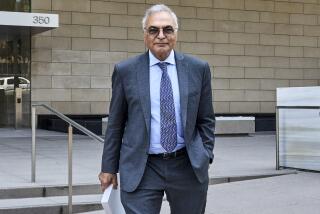For this doctor, it was patch and go
Physician Ahmad Toufanian remembers moving a particularly beefy patient off an operating table last year when he felt a sudden sharp pain in his left groin.
He didnât think much of it at first, but the pain persisted for several weeks. Toufanian underwent blood tests and a CT scan to rule out a possible tumor, but when he felt something he hadnât before -- a slight protrusion in his left groin area -- he knew immediately he had a hernia. After all, the 62-year-old Florida surgeon has performed hundreds of pediatric hernia operations.
Each year, about 750,000 people (the vast majority of them men) undergo hernia surgery, making it among the most common surgical procedures in the country. The term âherniaâ most often describes a bulge of fat tissue and intestines that protrudes through a weak area in the abdominal wall. Physicians often liken the condition, more precisely known as an inguinal hernia, to a worn-out bicycle tire in which the inner tube has popped out through a worn tire wall.
The most common symptom, as in Toufanianâs case, is pain in either groin area. The discomfort often is a precursor to the bulge, although in other cases those symptoms can appear in reverse order.
Once a hernia exists, additional stomach pressure such as coughing or even light lifting can cause it to grow by forcing more fat and intestine out of the abdominal cavity. The intestine is always contained within the protrusion of fat and tissue known as the hernia sac, and will usually continue to expand -- in rare cases up to several feet.
âI know some doctors who have had patients come in with it hanging down to their knees,â said Dr. Parviz Amid, co-founder and director of the Los Angeles-based Lichtenstein Hernia Institute, which specializes in research, teaching and developing surgical techniques. âMy personal record is one down to his shoes.â
The hernia can be pushed back inside the abdominal cavity temporarily, but without surgery to correct it, the patient will continue to have discomfort. Special trusses and binders can hold in the protrusion, but doctors usually warn against them.
Patients who wear the devices run the risk of developing an âincarceratedâ hernia, a potentially life-threatening situation in which the blood supply is cut off to the protruding tissues. If the blood supply isnât restored quickly, gangrene can set in, and the patient could die if not operated on immediately.
Until about two decades ago, doctors believed that the primary cause of a hernia was heavy lifting.
Since then, research has shown that hernias are the result of a metabolic disorder in which the body fails to produce enough of a certain type of collagen that helps keep connective tissues firm.
For a patient with the disorder, heavy lifting or even a forceful cough can trigger a hernia, because the skin in the groin area is particularly thin.
The disorder also means a hernia patient has a 10% to 20% chance of getting another hernia in his or her lifetime, studies show.
Although not a direct cause, being overweight can contribute to the likelihood of a hernia. Extra fat tissue puts more stress on the abdomen, making a rupture more likely.
For Toufanian, surgery was never in doubt. His only decision was who would do the procedure. Toufanian remembered hearing Amid lecture about hernias several month earlier at a convention. âAt the time I didnât have a hernia, of course, but I said to myself if I ever get one, Iâm going to have Dr. Amid do it,â Toufanian said.
During the early 1980s, Amid was among the pioneers in developing a technique for hernia operations that markedly reduced recurrence rates, which for more than a century had stood at 10% to 30%.
Traditional methods of hernia repair called for sewing together the edges of the abdominal gap. Although the procedure sealed the opening, the area was susceptible to tearing again -- much like a sewn hole in the knee in a pair of old jeans.
The technique calls for placing plastic mesh over the hole. Within two to three weeks, the mesh becomes part of the patientâs body, with tissue growing into the patch, Amid said. With todayâs techniques, the recurrence rates have dropped to less than 1%.
Toufanianâs surgery was performed on an outpatient basis under local anesthesia. Amid made an incision less than 3 inches long in the left groin and implanted the plastic mesh over the opening.
The procedure lasts about 45 minutes, and Toufanian remembers chatting with Amid as he operated. âI knew exactly what he was doing the whole time,â said Toufanian, who flew to Los Angeles for the surgery several months ago.Within hours after the surgery, Toufanian was cleared to go home with no restrictions on his physical activity.
Depending on their personal motivation and discomfort level, patients usually can return to work in two to 10 days. Toufanian took prescription pain medication for two days, and after that took Tylenol for several more days to treat lingering discomfort.
Within two weeks of the surgery, Toufanian was back to normal. Other than a small scar on his groin, he hardly knew he had had the surgery. âI started running and jogging again,â Toufanian said. âI was completely recovered. I felt fantastic.â
*
Getting Better tells the personal stories of people trying to achieve optimal health and well-being. Send ideas for future columns to [email protected] or to Health, Attn.: Getting Better, 202 W. 1st St., Los Angeles, CA 90012.





